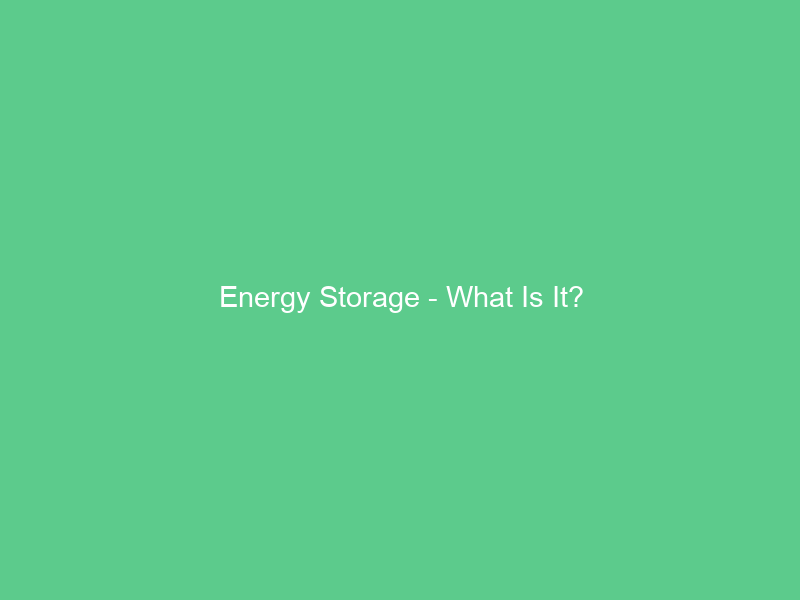Energy storage enables us to manage demand, strengthen community resiliency and accelerate the transition to renewables. Its use may occur at both grid level or on private premises as an installation “behind the meter.”
Coal, natural gas and crude oil can easily be stored as they exist; while wind, solar, and tidal forms must first be converted to secondary forms before being stored away for later use.
Battery Storage
Battery energy storage transforms electrical power into chemical energy via electro-chemical reactions, making it a key technology for grid-scale energy storage systems and residential energy storage batteries alike.
Utility-scale battery energy storage systems (BESSs) in the United States currently boast an operating nameplate power capacity of 8,842MW and annual energy capacity of 11,105 MWh, the majority being installed alongside solar PV or wind projects.
BESSs provide energy arbitrage to your power costs by storing low-priced electricity during low-demand periods and discharging it during higher cost periods. They also help regulate voltage, provide voltage regulation and defer costly distribution and transmission investments to enhance local resource adequacy.
Lithium-ion battery storage stands out from other forms of energy storage by being relatively safe and having a proven track record. It can be installed either behind-the-meter or for utility applications and its fast response and flexibility can provide your organization with energy market services to support growth.
Hydrogen Storage
Hydrogen storage helps mitigate the intermittent nature of wind and solar by converting surplus renewable electricity into hydrogen, which can then be stored as a clean fuel for later power generation. Furthermore, hydrogen energy may also supplement fossil fuel use where electrification is not possible – such as home heating, industry production and shipping applications.
Hydrogen can be stored both as an underground cavern gas and as a liquid in tanks; compressed into liquid form for transport over longer distances via dedicated pipelines; discharged as pure gas or converted back to electricity using an electrolyser or fuel cell.
Hydrogen has an energy density that falls well short of meeting vehicular usage needs, making its deployment prohibitively expensive and requiring compression or liquefaction processes for efficient use. New physisorption technologies which bind hydrogen with metal hydrides or other materials offer much higher storage densities which would make vehicular applications much more practical without impacting passenger space significantly.
Biofuels Storage
Biofuel refers to any liquid fuel produced from biomass feedstocks, such as bioethanol and biodiesel (also referred to as FAME or fatty acid methyl ester), renewable heating oil, biojet fuel, sustainable aviation fuel or even biogas that has been liquefied and used as biofuel. Their names vary depending on government legislation, incentive programs or industry branding/marketing efforts; examples of such biofuels are bioethanol, biodiesel (also referred to as FAME or fatty acid methyl ester), renewable heating oil renewable heating oil renewable heating oil renewable heating oil biojet fuel sustainable aviation fuel biogas can also be liquefied for use as biofuel. Biogas can also be liquefied for use as biofuel; alternative names for these biofuels may vary depending on government legislation incentive programs or industry branding/marketing efforts by industries.
As with traditional fuels, biofuels must also comply with specific storage regulations to be safely stored. Containers must be constructed from materials compatible with their type of biofuel, clearly labeled, and kept in an airtight environment. Prior to storing any flammable substances it’s a good idea to consult your insurance broker and local authorities to make sure you comply with applicable laws and safety guidelines; double wall construction tanks such as Western Global tanks meet this criteria, making them well suited for biofuel storage needs.
Electrochemical Storage
Electrochemical systems enable direct conversion of chemical energy into electrical energy without using traditional diesel generators; these eliminate thermal and mechanical steps for higher energy and power density.
Today’s most prominent electrochemical energy storage devices include batteries and redox flow cells. Batteries are light, inexpensive and offer multiple charge/discharge cycles, while redox flow cells offer even greater flexibility in terms of storage capacities and charge/discharge cycles. Unfortunately, however, batteries deteriorate rapidly over time due to accumulations of acid (in lead-acid batteries) or plate sulfation in nickel-cadmium batteries, ultimately leading to irreparable damage that requires replacement or recycling efforts.
Redox flow batteries offer higher energy densities but lower power densities due to their slower reaction kinetics, so new electrode materials that offer fast molecular and ion transport have been researched such as transition-metal carbides, nitrides and carbonitrides (collectively known as MXenes) with promising performance characteristics and are being explored for use as batteries.

